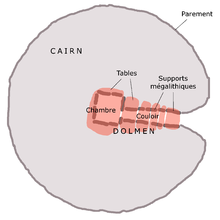Tumulus of Kercado
The tumulus of Kercado is located at one of the highest points in the area in the woods around Carnac , south of Kermario, in the Morbihan department in Brittany . It is dated to around 4700 BC. And is one of the oldest megalithic structures in Europe.
Digs
The monument was excavated and restored in 1863 by R. Galles and again in 1925 by Zacharie Le Rouzic (1864–1939). He put the imposing menhir on the hill.
description
The hill is about 40 m in diameter and was probably bordered by curbs. It was surrounded by a partially preserved circle of smaller menhirs.
The access to the chamber is in the direction of the winter solstice. The rectangular chamber (3.2 × 2.2 m) is accessed via a 6.5 m long rectangular corridor. 17 monoliths form the bearing stones of the chamber and corridor. The corridor is covered by five stones and the chamber by a single stone. What is curious about a passage grave is that most of the capstones in the passage are separated from the bearing stones by a high layer of dry masonry .
Motifs
Three of the bearing stones in the corridor and four stones in the chamber bear incised motifs similar to those of Mané Kerioned or Le Petit Mont on the Rhuys Peninsula (Arzon). The northern stone at the entrance to the chamber has an anthropomorphic shape, which was probably created artificially. The capstone of the chamber is adorned with a large ax plow (hache carrure). Similar signs show steles (Mané-er-Hroek, Table des Marchands) in Locmariaquer . The exact outline of the huge capstone of the chamber is unknown, but the unusual positioning of the sign and similar cases in the vicinity ( Gavrinis , Mané Rutual) suggest that this stone too was a former flat menhir that was smashed and reused.
Finds
Artifacts of a number of buried people were found in the chamber and passage ( axes , pearls , arrowheads and 147 variscite beads ). In addition, there were shattered ceramics from the late Neolithic and the bell-cup culture . The complex was built around 4600 BC. It was built and used for around 3,000 years.
See also
literature
- Pierre-Roland Giot , Jacques Briard : Protohistoire de la Bretagne . Ouest-France, Rennes 1979, ISBN 2-858820-89-9 , ( Université ).
- Jacques Briard: Mégalithes de Bretagne . Ouest-France, Rennes 1987, ISBN 2-7373-0119-X .
Individual evidence
- ↑ Ker is a Breton appellative that is often used as a prefix for place names. It means: "inhabited place".
Web links
Coordinates: 47 ° 35 ′ 45 " N , 3 ° 3 ′ 14" W.


